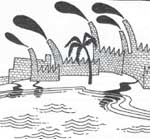Devastating showpiece
 The Dakshina Kannada district will become Karnataka's showpiece of industrial development, the state government has been saying. However, a study begun in 1993 has projected a rather depressing environmental scenario. The report tabled in February warns that uncontrolled industrialisation will have "dire implications" for the area's terrestrial, riverine and marine ecosystems.
The Dakshina Kannada district will become Karnataka's showpiece of industrial development, the state government has been saying. However, a study begun in 1993 has projected a rather depressing environmental scenario. The report tabled in February warns that uncontrolled industrialisation will have "dire implications" for the area's terrestrial, riverine and marine ecosystems.
The study was carried out by the state government's department of forests, environment and ecology, in collaboration with the Danish International Development Agency.
On the basis of the plans already announced by public agencies and private entrepreneurs, the study team has estimated that there will be more than 17 large scale industrial units in the district by 2002, in comparison to the 9 today. Medium sized units will go up from 34 to approximately 80, and small scale industries increase from 9,000 to 18,000 -- a straight double.
The study has noted that this mammoth growth will see a massive spurt in emissions and effluents. Polluting emissions from the large-scale industries alone may increase by 9 times, and waste-water discharge by 4 times. The generation of hazardous industrial wastes could increase by about 14 million tonnes annually. The industrialisation will be accompanied by the growth of an urban sprawl, and 4,000 hectares of picturesque rural land in the Mangalore taluka will go under macadam and concrete.
The authors of the study stress the necessity for determining the strain that this growth will put on the natural resources of this region. Thus, the study estimates that the industrial demand for water to increase from the present level of 58 million to 238 million liters. The Karnataka government is establishing a multi-departmental group to draw up an action plan based on the recommendations of the study.
